Human emerging respiratory pathogens bulletin: Issue 72, December 2022
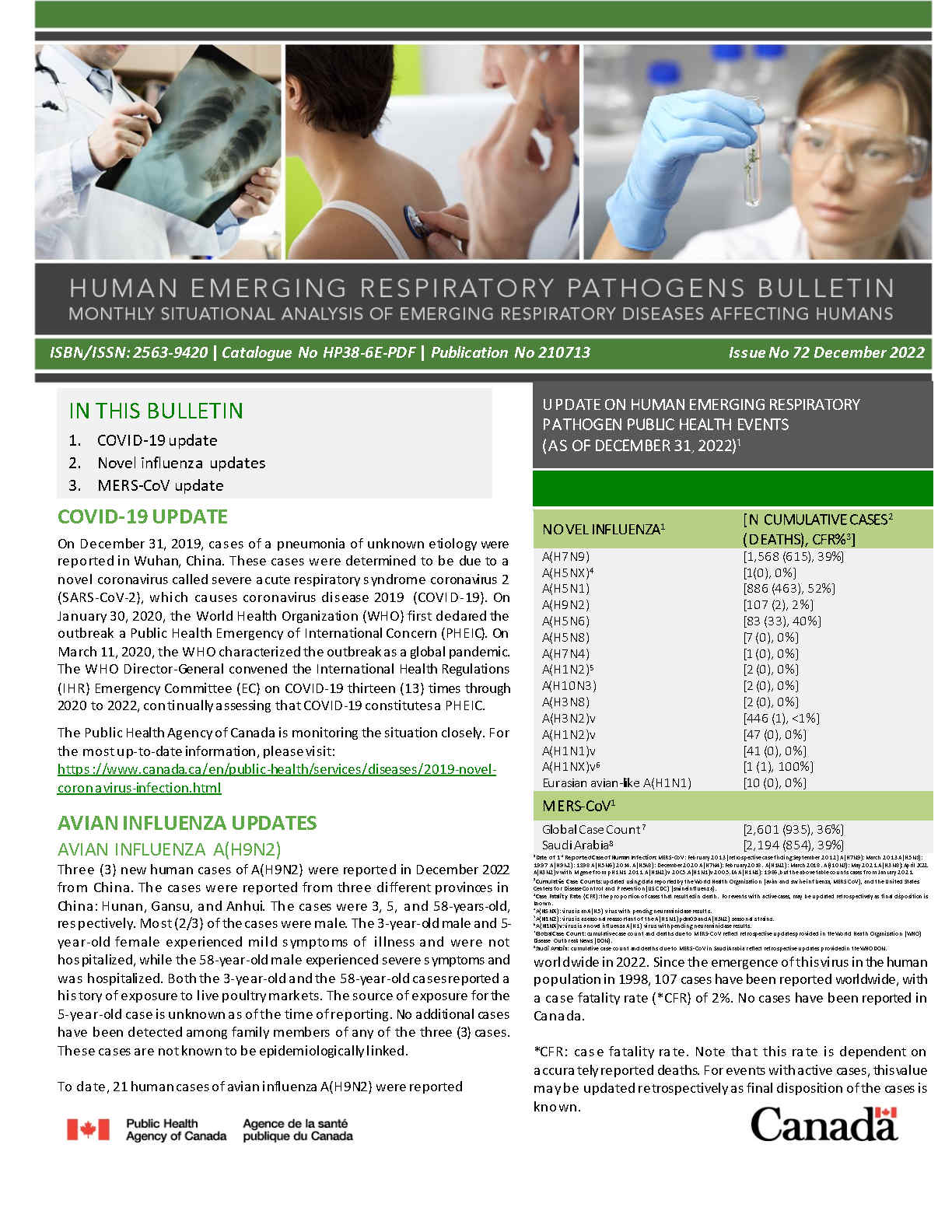
Download the alternative format
(PDF format, 1.32 MB, 3 pages)
Organization: Public Health Agency of Canada
Published: 2022-01-10
Monthly situational analysis of emerging respiratory diseases affecting humans (data to December 31, 2022).
In this bulletin
- COVID-2019 update
- Avian influenza updates
- Swine influenza updates
- Middle East respiratory syndrome coronavirus (MERS-CoV) update
| Novel influenzaFootnote 1 | Cumulative Case CountFootnote 2 | Deaths | Case Fatality Rate %Footnote 3 |
|---|---|---|---|
| A(H7N9) | 1,568 | 615 | 39% |
| A(H5N1) | 886 | 463 | 52% |
| A(H5NX)Footnote 4 | 1 | 0 | 0% |
| A(H9N2) | 107 | 2 | 2% |
| A(H5N6) | 83 | 33 | 40% |
| A(H5N8) | 7 | 0 | 0% |
| A(H7N4) | 1 | 0 | 0% |
| A(H1N2)Footnote 5 | 2 | 0 | 0% |
| A(H10N3) | 2 | 0 | 0% |
| A(H3N8) | 2 | 0 | 0% |
| A(H3N2)v | 446 | 1 | <1% |
| A(H1N2)v | 47 | 0 | 0% |
| A(H1N1)v | 41 | 0 | 0% |
| A(H1NX)vFootnote 6 | 1 | 1 | 100% |
| Eurasian avian-like A(H1N1) | 10 | 0 | 0% |
| MERS-CoVFootnote 1 | Cumulative Case CountFootnote 2 | Deaths | Case Fatality Rate %Footnote 3 |
| Global Case CountFootnote 7 | 2,601 | 935 | 36% |
| Saudi ArabiaFootnote 8 | 2,194 | 854 | 39% |
Footnotes
|
|||
COVID-19 update
On December 31, 2019, cases of a pneumonia of unknown etiology were reported in Wuhan, China. These cases were determined to be due to a novel coronavirus called severe acute respiratory syndrome coronavirus 2 (SARS-CoV-2), which causes coronavirus disease 2019 (COVID-19). On January 30, 2020, the World Health Organization (WHO) first declared the outbreak a Public Health Emergency of International Concern (PHEIC). On March 11, 2020, the WHO characterized the outbreak as a global pandemic. The WHO Director-General convened the International Health Regulations (IHR) Emergency Committee (EC) on COVID-19 thirteen (13) times through 2020 to 2022, continually assessing that COVID-19 constitutes a PHEIC.
The Public Health Agency of Canada is monitoring the situation closely.
Avian influenza updates
Avian influenza A(H9N2)
Three (3) new human cases of A(H9N2) were reported in December 2022 from China. The cases were reported from three different provinces in China: Hunan, Gansu, and Anhui. The cases were 3, 5, and 58-years-old, respectively. Most (2/3) of the cases were male. The 3-year-old male and 5-year-old female experienced mild symptoms of illness and were not hospitalized, while the 58-year-old male experienced severe symptoms and was hospitalized. Both the 3-year-old and the 58-year-old cases reported a history of exposure to live poultry markets. The source of exposure for the 5-year-old case is unknown as of the time of reporting. No additional cases have been detected among family members of any of the three (3) cases. These cases are not known to be epidemiologically linked.
To date, 21 human cases of avian influenza A(H9N2) were reported worldwide in 2022. Since the emergence of this virus in the human population in 1998, 107 cases have been reported worldwide, with a case fatality rate (*CFR) of 2%. No cases have been reported in Canada.
*CFR: case fatality rate. Note that this rate is dependent on accurately reported deaths. For events with active cases, this value may be updated retrospectively as final disposition of the cases is known.
Avian influenza A(H5N6)
One (1) new human case of avian influenza A(H5N6) was reported in December 2022 from China. The case was a 54-year-old male from Hunan province, China. He was hospitalized and in critical condition as of the time of reporting. No source of exposure has been identified; however, the case worked in a restaurant preparing food, which may provide the potential for occupational exposure to sick and/or infected poultry. No close contacts of the case reported symptoms at the time of last report.
A total of 83 laboratory-confirmed human cases of avian influenza A(H5N6), including at least 33 deaths (CFR: 40%) have been reported globally since 2014. Since January 2021, 57 cases of avian influenza A(H5N6) have been reported globally (Figure 2); 56 A(H5N6) cases were reported from China and one (1) case was reported from Lao PDR (Figure 3). So far, 25 A(H5N6) human cases have been reported worldwide in 2022. No cases have been reported in Canadian residents.
Avian influenza A(H5N1)
The most recent human case of avian influenza A(H5N1) was reported in November 2022 from China. In December 2022, the WHO linked the human case of avian influenza A(H5N1) in China from November 2022 and the human case of A(H5NX) in Vietnam from October 2022 to the clade 2.3.4.4b.
There have been 886 human cases of A(H5N1) reported globally since 1997, with a CFR of 52% (Figure 4). Five (5) human infections with A(H5N1) and one (1) case of A(H5NX) have been reported worldwide in 2022, all linked to the highly pathogenic avian influenza (HPAI) outbreak in domestic poultry, wild birds, and some mammals that continues to evolve in Europe and the Americas. The four (4) human cases from Europe, the UK and North America were mild/asymptomatic and the two (2) human cases from Asia were fatal/severe. These two (2) recent detections from Asia provide additional information regarding the spectrum of disease caused by A(H5N1) viruses belonging to the clade 2.3.4.4b such that severe and fatal outcomes can be expected. According to the WHO, the risk of infection for humans remains low and no sustained human-to-human transmission has been reported.
No domestically acquired A(H5N1) infections have ever been reported in Canada, although a significant number of A(H5N1) detections associated with the current 2021-2022 epizootic have been reported in domestic, backyard, wild bird populations, and other wild animal species across Canada. In 2014, Canada (Alberta) reported one single fatal case of A(H5N1) in a resident returning from travel in China.
Swine influenza updates
Swine origin influenza A(H1N2)v
One (1) new human case of avian influenza A(H1N2)v was reported in December 2022 from Taiwan. The case was a 7-year-old female who was living in Changhua County, Taiwan. She experienced influenza-like symptoms and was treated with antivirals. The case was not hospitalized and has since recovered from illness. The case lived with her family who own a pig barn in Changhua; however, the case had no direct exposure to pigs prior to illness onset. Six (6) close contacts were identified, two (2) of whom reported influenza-like illness; however, all close contacts tested negative for A(H1N2)v.
A total of 47 A(H1N2)v cases have been reported globally since 2005, with a 0% case fatality rate. Eight (8) A(H1N2)v cases have been reported worldwide in 2022. Three (3) A(H1N2)v detections have been reported in Canadian residents since reporting began in 2005, and the latest case in Canada was reported in November 2021 from Manitoba.
Swine origin influenza A(H3N2)v
The most recent human case of avian influenza A(H3N2)v was reported in November 2022 from China.
Globally, 446 A(H3N2)v cases have been reported since 2005, with <1% case fatality rate. Five (5) A(H3N2)v cases have been reported worldwide in 2022. Two (2) A(H3N2)v detections have been reported in Canadian residents since reporting began in 2005, with the latest case reported in June 2021.
Swine origin influenza A(H1N1)v
The most recent human case of swine origin influenza A(H1N1)v was reported in October 2022 from Brazil.
Globally, 41 human cases of A(H1N1)v have been reported since 2005, with no associated fatalities. Four (4) A(H1N1)v cases have been reported worldwide in 2022. Two (2) A(H1N1)v detections have been reported in Canadian residents since reporting began in 2005, with the latest case reported in April 2021.
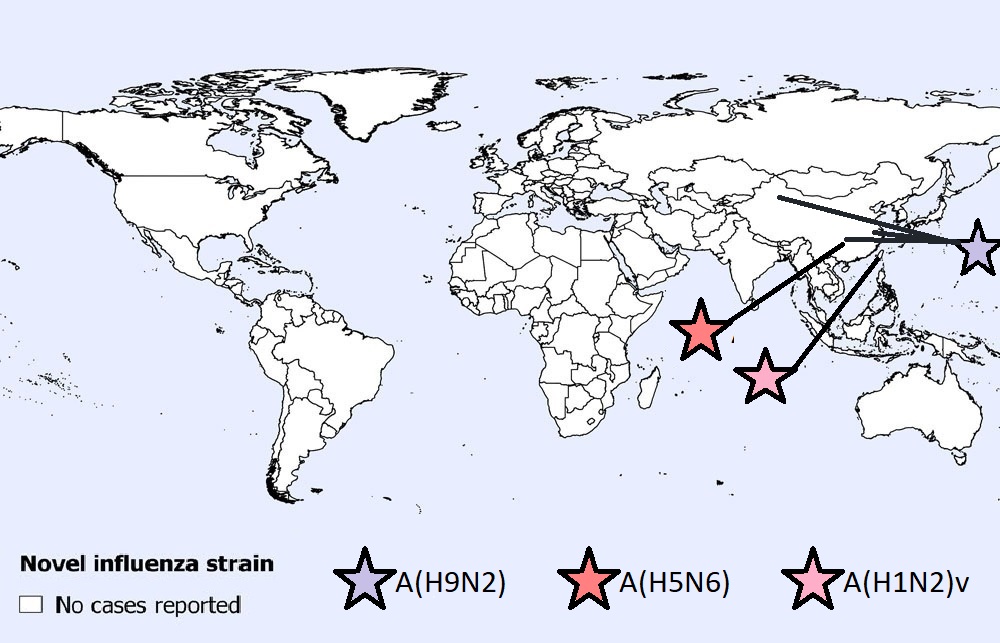
Figure 1 - Text description
Three (3) A(H9N2) cases were reported in China.
One (1) A(H5N6) case was reported in China.
One (1) A(H1N2)v case was reported in Taiwan.
Note: Map was prepared by the Centre for Immunization and Respiratory Infectious Diseases (CIRID) using data from the latest WHO Event Information Site (EIS) postings. This map reflects data available through these publications as of December 31, 2022.
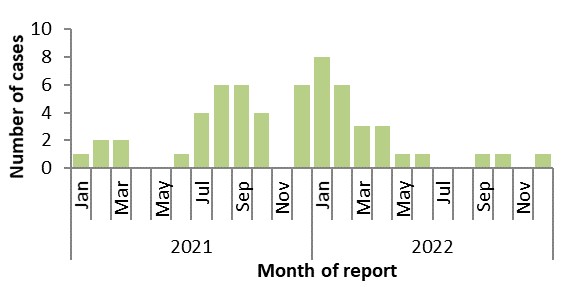
Figure 2 - Text description
| Year | Month | Cases |
|---|---|---|
| 2021 | Jan | 1 |
| Feb | 2 | |
| Mar | 2 | |
| Apr | 0 | |
| May | 0 | |
| June | 1 | |
| July | 4 | |
| Aug | 6 | |
| Sep | 6 | |
| Oct | 4 | |
| Nov | 0 | |
| Dec | 6 | |
| 2022 | Jan | 8 |
| Feb | 6 | |
| Mar | 3 | |
| Apr | 3 | |
| May | 1 | |
| June | 1 | |
| July | 0 | |
| August | 0 | |
| Sep | 1 | |
| Oct | 1 | |
| Nov | 0 | |
| Dec | 1 |
Note: Graph was prepared by the Centre for Immunization and Respiratory Infectious Diseases (CIRID) using data from the WHO EIS postings and the Hong Kong Centre for Health Protection (CHP) press releases. This graph reflects data available as of December 31, 2022.
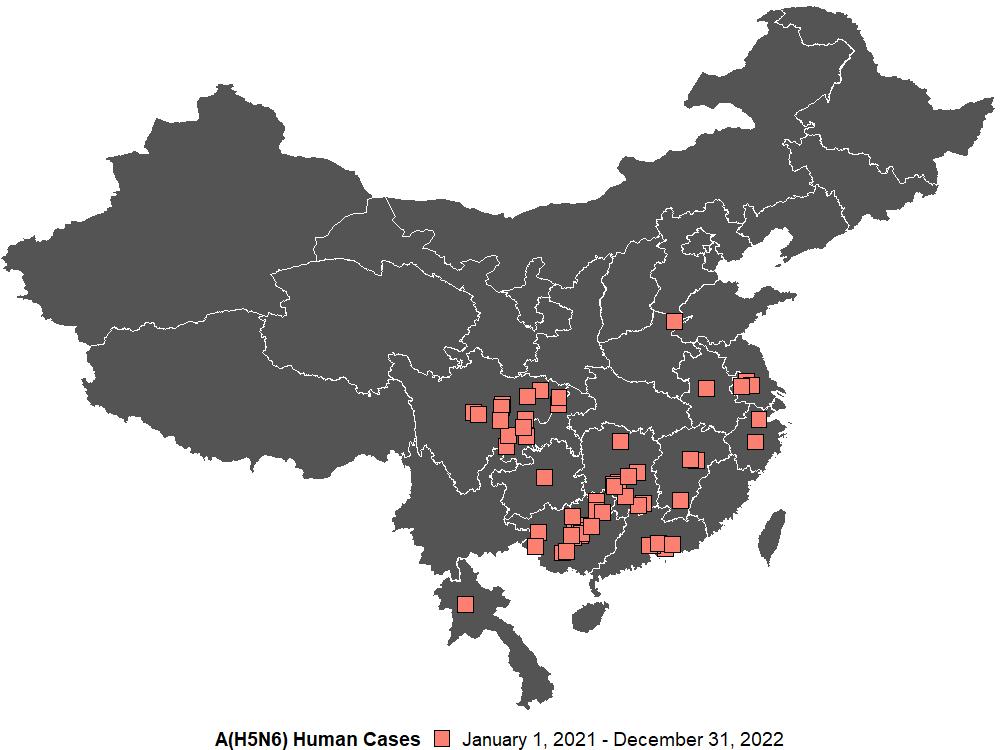
Figure 3 - Text description
Four cases were reported out of Yongzhou, Hunan Province, People's Republic of China.
Three cases were reported out of Guilin, Guangxi Zhuang Autonomous Region, People's Republic of China.
Three cases were reported out of Huizhou, Guangdong Province, People's Republic of China.
Three cases were reported out of Liuzhou, Guangxi Zhuang Autonomous Region, People's Republic of China.
Two cases were reported out of Baise, Guangxi Zhuang Autonomous Region, People's Republic of China.
Two cases were reported out of Chengdu, Sichuan Province, People's Republic of China.
Two cases were reported out of Chenzhou, Hunan Province, People's Republic of China.
Two cases were reported out of Dongguan, Guangdong Province, People's Republic of China.
Two cases were reported out of Guangxi Zhuang Autonomous Region, People's Republic of China.
Two cases were reported out of Hechi, Guangxi Zhuang Autonomous Region, People's Republic of China.
Two cases were reported out of Hengyang, Hunan Province, People's Republic of China.
Two cases were reported out of Sichuan Province, People's Republic of China.
Two cases were reported out of Tongnan District, Chongqing Municipality, People's Republic of China.
Two cases were reported out of Zhenjiang, Jiangsu Province, People's Republic of China.
One case was reported out of Anhui Province, People's Republic of China.
One case was reported out of Bazhong, Sichuan Province, People's Republic of China.
One case was reported out of Changde, Hunan Province, People's Republic of China.
One case was reported out of Deyang City, Sichuan Province, People's Republic of China.
One case was reported out of Fuzhou, Fujian Province, People's Republic of China.
One case was reported out of Ganzhou City, Jiangxi Province, People's Republic of China.
One case was reported out of Guizhou Province, People's Republic of China.
One case was reported out of Hangzhou, Zhejiang Province, People's Republic of China.
One case was reported out of Jiangxi Province, People's Republic of China.
One case was reported out of Kaijiang County, Sichuan Province, People's Republic of China.
One case was reported out of Laibin, Guangxi Zhuang Autonomous Region, People's Republic of China.
One case was reported out of Langzhong City, Sichuan Province, People's Republic of China.
One case was reported out of Luang Prabang Province, Lao People's Democratic Republic (the).
One case was reported out of Nanning, Guangxi Zhuang Autonomous Region, People's Republic of China.
One case was reported out of Puyang City, Henan Province, People's Republic of China.
One case was reported out of Xuanhan County, Sichuan Province, People's Republic of China.
One case was reported out of Yangzhou, Jiangsu Province, People's Republic of China.
One case was reported out of Yibin, Sichuan Province, People's Republic of China.
One case was reported out of Yongchuan District, Chongqing Municipality, People's Republic of China.
One case was reported out of Zhejiang Province, People's Republic of China.
One case was reported out of Zigong City, Sichuan Province, People's Republic of China.
One case was reported out of Nanning, Guangxi Province, People's Republic of China.
One case was reported out of Guangxi Zhuang Autonomous Region, People's Republic of China.
One case was reported out of Changsa, Hunan Province, People's Republic of China.
Note: Map was prepared by the Centre for Immunization and Respiratory Infectious Diseases (CIRID) using data from the WHO EIS postings and the Hong Kong Centre for Health Protection (CHP) press releases. This map reflects data available through these publications as of December 31, 2022.
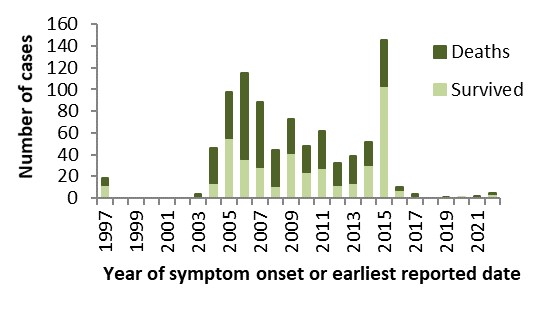
Figure 4 - Text description
| Year | Number of Cases | Deaths | Survived |
|---|---|---|---|
| 1997 | 18 | 6 | 12 |
| 1998 | 0 | 0 | 0 |
| 1999 | 0 | 0 | 0 |
| 2000 | 0 | 0 | 0 |
| 2001 | 0 | 0 | 0 |
| 2002 | 0 | 0 | 0 |
| 2003 | 4 | 4 | 0 |
| 2004 | 46 | 32 | 14 |
| 2005 | 98 | 43 | 55 |
| 2006 | 115 | 79 | 36 |
| 2007 | 88 | 59 | 29 |
| 2008 | 44 | 33 | 11 |
| 2009 | 73 | 32 | 41 |
| 2010 | 48 | 24 | 24 |
| 2011 | 62 | 34 | 28 |
| 2012 | 32 | 20 | 12 |
| 2013 | 39 | 25 | 14 |
| 2014 | 52 | 22 | 30 |
| 2015 | 145 | 42 | 103 |
| 2016 | 10 | 3 | 7 |
| 2017 | 4 | 2 | 2 |
| 2018 | 0 | 0 | 0 |
| 2019 | 1 | 1 | 0 |
| 2020 | 1 | 0 | 1 |
| 2021 | 2 | 1 | 1 |
| 2022 | 5 | 1 | 4 |
Note: Graph was prepared by the Centre for Immunization and Respiratory Infectious Diseases (CIRID) using data from the WHO EIS postings, the US CDC's Health Alert Network (HAN), and WHO cumulative case counts. This graph reflects data available as of December 31, 2022.
Middle East respiratory syndrome coronavirus (MERS-CoV) update
One (1) new human case of MERS-CoV was reported in December 2022 from Saudi Arabia. No additional case details were reported.
According to the WHO, 2,601 laboratory-confirmed cases of MERS-CoV, including 935 deaths, have been reported globally since reporting began in 2012 (CFR: 36%). Seven (7) MERS-CoV cases have been reported worldwide to the WHO in 2022. No cases have been reported in Canada.
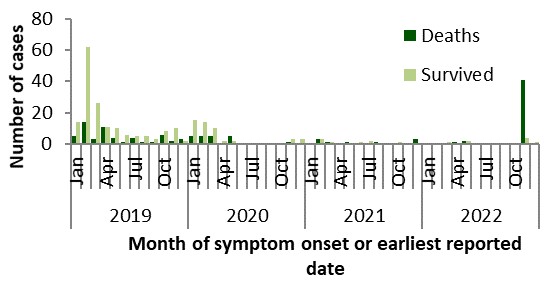
Figure 5 - Text description
Temporal distribution of human cases of MERS-CoV reported to the WHO, globally, by month and year, January 1, 2019 to December 31, 2022 (n=319).| Year | Month | Deaths | Survived |
|---|---|---|---|
| 2019 | Jan | 5 | 14 |
| Feb | 14 | 62 | |
| Mar | 3 | 26 | |
| Apr | 11 | 11 | |
| May | 4 | 10 | |
| June | 1 | 6 | |
| July | 4 | 5 | |
| Aug | 1 | 5 | |
| Sep | 1 | 3 | |
| Oct | 6 | 8 | |
| Nov | 2 | 10 | |
| Dec | 3 | 2 | |
| 2020 | Jan | 5 | 15 |
| Feb | 5 | 14 | |
| Mar | 5 | 10 | |
| Apr | 0 | 2 | |
| May | 5 | 2 | |
| June | 0 | 0 | |
| July | 0 | 0 | |
| Aug | 0 | 0 | |
| Sep | 0 | 0 | |
| Oct | 0 | 0 | |
| Nov | 1 | 3 | |
| Dec | 0 | 3 | |
| 2021 | Jan | 0 | 0 |
| Feb | 3 | 3 | |
| Mar | 1 | 1 | |
| Apr | 0 | 0 | |
| May | 1 | 0 | |
| June | 0 | 1 | |
| July | 0 | 2 | |
| Aug | 1 | 0 | |
| Sep | 0 | 0 | |
| Oct | 0 | 1 | |
| Nov | 0 | 0 | |
| Dec | 3 | 0 | |
| 2022 | Jan | 0 | 0 |
| Feb | 0 | 0 | |
| Mar | 0 | 1 | |
| Avr | 1 | 0 | |
| May | 2 | 2 | |
| June | 0 | 0 | |
| July | 0 | 0 | |
| Aug | 0 | 0 | |
| Sep | 0 | 0 | |
| Oct | 0 | 0 | |
| Nov | 41 | 4 | |
| Dec | 0 | 1 |
Note: Graph was prepared by the Centre for Immunization and Respiratory Infectious Diseases (CIRID) using data from the WHO Disease Outbreak News (DON) and Saudi Arabia’s Ministry of Health. This graph reflects data available as of December 31, 2022. The data integrates CIRID real-time reporting with WHO DON retrospective reporting of MERS-CoV cases and deaths. In November 2022, the WHO published a Disease Outbreak News (DON) article that updated their counts with retrospective cases and deaths, which resulted in an increase of an additional 5 cases and 41 deaths compared to their previous MERS-CoV-related DON.